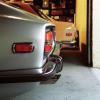Search the Community
Showing results for tags 'flange'.
-
Hi all, long time lurker, first time poster here. Quick intro: My name is Dirk, I have a '73 240Z and '70 510. The 510 is the car I've learned to wrench on since I got it a few years ago. The Z has become my rolling project and daily driver since I bought it about half a year ago. Powertrains are stock-ish on both but I'm planning an L28 NA build for the Z. I'm fairly mechanically inclined and have completed a bunch of moderately challenging projects on both cars, but I'm entirely self-taught and far from an expert. My questions: I'm getting ready to swap a Subie R180 Torsen diff from an '08 STi into the Z, a fairly fresh used diff and the betamotorsport stub axles are on their way to my home, as well as a Ron Tyler mount while I'm in there, and I've done a bunch of research on the swap so far. This is the best illustrated how-to I could find on the swap: http://inzane240.blogspot.com/2014/01/subie-r180-install.html At this point, everything but swapping the input flange seems really straightforward to me. The best thread I could find on that topic was this one: http://forums.hybridz.org/topic/90321-r200-clsd-mounting/ But since that thread is about a different diff than the one I'm going to use, I'm not sure if the same tolerances and advice apply. I'm asking specifically for advice on how to retighten the flange nut in the best possible way so I end up with a safe, reliable set-up. What I believe so far is: The flanges should swap straight between my stock open R180 and the Subie R180 I can remove the nuts for the flanges on both diffs with an impact I might need a puller to get one of the flanges off, but probably won't When putting the Datsun flange on the Subie diff, I should put red loctite on the nut and tighten it to around 137 ft-lb The Subie diff doesn't use a crush washer for preload of the bearing or anything complicated like that, so no to count rotations of the nut when coming of, or to measure flange thickness. I can just tighten to spec, and then just check that the diff still rotates freely. If you see any errors in the above, please let me know. Now the next steps are where I'm getting a little lost and this is where my lack of expertise as a mechanic shows: When tightening the nut with an impact, it's really easy to overdo it. But when trying to using a torque wrench the diff will spin before tightening that nut. I see a few possible options to do this, and would like to hear your recommendations (or if you know of an alternate approach that I've overlooked, even better): Put the diff on a bench, put the flange in a vice. This allows me to tighten the nut with a torque wrench without spinning the input shaft. (seems like the best option. only worry: damaging the flange with the vice). Assemble input flange but don't fully tighten it, install the diff in the car, connect half-shafts to it but before connecting drive-shaft, put on the parking brake, raise car again, and tighten the input flange nut to spec while on the car. (seems like the surest option as long as I don't forget to tighten the nut. worry: seems like a hassle and means that if anything binds internally after tightening – e.g. seal against flange – I have to remove the diff again) Just jam the nut on there with my impact driver (I have an electric one that's capable of delivering somewhere between 150 and 250 ftlb of torque), even if that over-tightens the nut. (quick and dirty, worry: damaging something by over-tightening) Approach 3 is what Jon Mortensen recommends in the above-mentioned thread, just get it RFT. But since that's about a different type of differential than the one I'm working with, I didn't want to assume the same advice works equally well for the Subie diff. I'm leaning toward option 1, since it seems the most straightforward way to get to spec. Option 3 also makes sense to me because I'm probably going to use a similar approach to tighten all the other nuts to spec (half shaft to stub axle, drive shaft to input flange). Any advice or recommendations appreciated, thanks!
- 15 replies
-
- differential
- LSD
-
(and 1 more)
Tagged with:
-
I'm in the process of installing a long nose R 200 limited slip differential with 280 ZX turbo tripod half shafts into a 240 Z. I have transferred the dust shield from the 240 Z companion flange to the 280 ZX turbo companion flange, although I'm not exactly sure why I needed to do that. However, as many of you know, there is a problem with the grease seal. There have been writeups in the past on this recommending using the R200 Pinion seal with the rubber removed off of the outside of the seal. However, in my circumstance, it was too large by 0.080in. By measuring the seal journal of the 280 ZX Turbo companion flange and the inner diameter of the housing for the 240 Z, I came up with the dimensions of 40 mm for the outside diameter of the companion flange seal journal, and 72 mm for the inside diameter of the 240 Z housing. So, there are several sources that make a 40 x 72 x 10mm grease seal. I ordered one from Timken and it was a perfect fit! Problem solved! I found this seal simply by google search. I hope this helps anyone trying to do this conversion.
-
In need of a early (25 spline) rear outer stub axle, just one, don't need the companion flange. OR could be talked into a full set of 280Z stub axles and companion flanges. I'm in Columbus, OH, but willing to pay shipping. Thanks! Ben
-
Can somebody do me a favor and measure the angle of the flanges that screw to the hatch hinges? Either inside angle, or outside angle. I am installing a fiberglass hatch and making the flanges myself. I just need that angle I have attached the dimensions that I measured in case somebody else needs them thanks! datsun hatch flange layout.pdf datsun hatch flange dimensions.pdf
-
where can I order a l28et stock turbo outlet flange?
subtle_driver posted a topic in Nissan L6 Forum
I tried to search for a flange, so I can make my own downpipe for my l28et swap into my 240z, on google and here, but no luck. The flange I need is the four bolt to downpipe.- 9 replies
-
- l28et turbo downpipe flange
- l28et
- (and 4 more)

